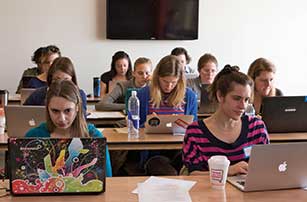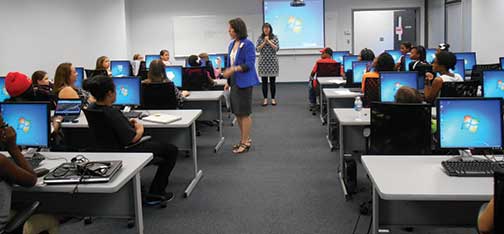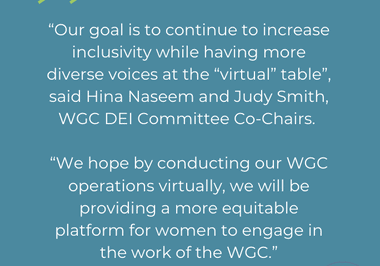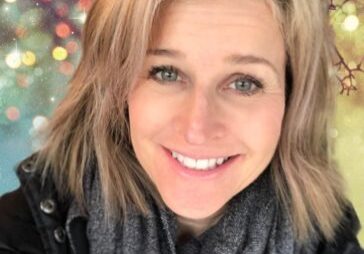GIRL GEEKS GET WITH THE PROGRAMMING.
STORY BY Barbara Pash
In late September of last year, 90-plus girls, elementary to high school age, gathered at a modest building in a semi-industrial park in Columbia. Normally the headquarters of an information technology training firm, for that 
Instead of watching music videos, the girls learned about sound waves. Instead of playacting with dolls, they learned about mobile apps. Trainers led lessons in coding software. Although many of the older girls brought their own laptops, there were computers to see and touch and use.
“There was a buzz of excitement. There was a lot of girl bonding,” says Kris Shock, executive director of the sponsor, Chesapeake Regional Tech Council (CRTC). Based on the success of the weekend event, CRTC plans to hold more girls-only tech programs.
The event brought together two separate groups: Rails Girls, an international nonprofit for middle and high school girls, and Cupcakes and Computers, a group founded by CRTC for kindergarten through grade 12.
Not knowing how many girls would attend, organizers decided to host the two groups simultaneously. As it turned out, 90 girls showed up, split evenly between Rails Girls and Cupcakes.

The gender gap in tech fields is well documented. The nonprofit National Center for Women and Information Technology reports, for example, that girls comprise only 19 percent of students who take the Advanced Placement computer science test; in 2009, just 18 percent of college degrees in computing and information science were awarded to women. And while women hold 56 percent of all professional jobs in the United States, only 25 percent of IT workers are women.
The gender gap is not a new problem. But in Howard County, there is a new solution.
Spearheading it is CRTC, a 300-member strong organization based in Annapolis and covering the geographic triangle from Washington, D.C., to Anne Arundel, Baltimore and Howard counties.
About two years ago, CRTC founded a subgroup, the Women in Technology Forum, for female members in tech and tech-related fields. “I thought we’d have networking, training and volunteering,” says Angie Lienert, a CRTC board member who initiated the forum and serves as the board’s liaison to it.
Lienert is familiar with the gender gap. The Columbia resident, a married mother of two, served in the U.S. Air Force and worked in the decidedly male-dominated defense/intelligence communities before starting her own contracting company, IntelliGenesis, in Columbia in 2007.
The way Lienert sees it, part of the forum’s mission is to encourage girls to think about technology by exposing them to innovative experiences. “You want them to see the fun things that can come out of technology,” she says, and the earlier that starts, the better.
To accomplish that mission, Lienert looked around for a program CRTC could offer, something “hands-on for girls,” she says, and she found it in Rails Girls. An international nonprofit for middle and high school girls – as well as women – to learn software coding, Rails Girls meetings are held in metro D.C. and Baltimore but, until then, not in Howard County.
CRTC initiated Rails Girls in the county, enlisting technical people and finding a location, says Lienert. She decided that if CRTC was hosting a Rails meeting, it could be extended to younger girls with an age-appropriate program.
Susan Schneider remembers what happened next. The forum’s eight-member steering committee, many of whom have young children, brainstormed what that program for younger girls should be.
“We created it and gave it a name, Cupcakes and Computers,” Schneider says of a program that is intended for K through 12th graders, with a focus on elementary school students, to give a taste of tech via short presentations on a variety of fields.
Schneider, a Columbia mother of four, ended up co-chairing the event with Lienert. She, too, knows about the gender gap. In 1979 when she was interviewing for admission to her first-choice college, she told the interviewer that she was interested in engineering. “I was told that I was” – she remembers the exact word – “overreaching.”
Schneider walked out of the interview. She subsequently graduated from Virginia Tech with an architecture/engineering degree, often the only woman in her engineering classes. In 1990, she founded her own successful IT training company, /training/ etc., where the weekend event was held.
Schneider’s company holds eight to nine tech training courses per week. Even now, registration typically runs anywhere from 100 percent male up to 15 to 30 percent female, depending on the course, she says.
Once the planning for the event was done, invitations went out in the form of social media and emails. The organizers didn’t know what to expect. Says Shock, “We thought we’d have a quiet event our first time. We thought, ‘Wouldn’t it be fun if we had 20 girls total?'”
Then, the calls from school and community groups started, an avalanche from Howard County, Baltimore City and neighboring Baltimore, Montgomery and Prince George’s counties. “An amazing outpouring of interest,” says Shock, that quickly outstripped the event’s capacity.
She even got calls from St. Mary’s County on the Eastern Shore, where school officials had heard of the event, had 40-plus girls who were interested in attending and were ready to hire a bus to bring them.
By then, though, registration had closed. In fact, registration for the 91 girls who did attend, closed within two days of opening. The event sold out, so to speak, even though it was free.
Perhaps CRTC shouldn’t have been so surprised at the response. Suddenly, it seems, tech education is huge. On the national scene, programs like Project Lead the Way and STEM (Science, Technology, Engineering and Mathematics) flourish in the local school systems.
Shirley Collier knows about that. Collier, a tech entrepreneur, has long been active in promoting girls and technology in Howard County. Her advocacy started when, as a member of Leadership Howard County in the mid-1990s, she learned that the public schools’ computer science classes enrolled 80 percent boys, 20 percent girls.
“I thought, ‘Really? We still have this problem?'” says Collier, CEO of Scale2Market, an executive consulting and technology development company in Marriottsville. Collier went on to organize girls-only computer events in the county and to advise the school system on implementing STEM education.
“We had a lot of discussions about what the problem was and how to solve it that led to policy changes,” Collier says of the gender gap. She believes, as do others, that parents and teachers play a vital role in sending cultural cues to girls.
The situation has improved but, according to Collier, not by much.
While more women are involved in technology fields these days, she says, “they’re in marketing, communications, customer service, the creative side like web development. They’re still not represented in computer networking and in tech entrepreneurship.”
As it plans future programs, CTRC is working to change that. It’s considering two Rails Girls programs each year, one in the spring in Anne Arundel County, the other in Columbia in the fall. Two Cupcakes and Computers programs are also in the planning, likewise divided between the two counties.
As for Schneider, she has a message for girls. Geek is good, she says, computers are cool. “I love this tech community and I’m actively looking for women instructors,” she says. “One of those Cupcakes and Computers girls may be a future employee.” *





